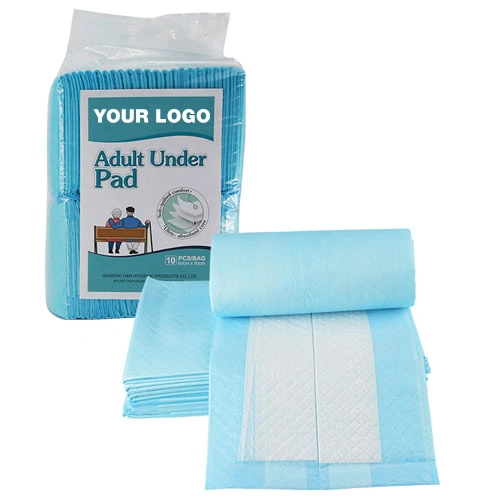Disposable medical underpads, often referred to as incontinence pads or bed pads, are essential for maintaining hygiene and protecting surfaces in healthcare settings and home care environments. The 90×60 cm size is one of the most commonly used dimensions, providing sufficient coverage for beds, chairs, and other surfaces. In this article, we will explore the structure, uses, and benefits of 90×60 cm disposable medical underpads.
Structure of a Disposable Medical Underpad
A typical disposable medical underpad consists of multiple layers designed to maximize absorbency and protect against leaks. Here’s a closer look at the different layers:
- Top Layer (Non-woven Fabric): This layer is soft and comfortable, designed to stay dry against the skin. It quickly absorbs liquid, keeping the surface dry and preventing skin irritation.
- Absorbent Core: The core of the pad usually contains super-absorbent polymers (SAP) and fluff pulp, which trap and convert liquid into a gel. This layer holds moisture, preventing it from leaking onto the surface below.
- Leak-Proof Barrier: The bottom layer is made of a waterproof material, often polyethylene (PE) film, that ensures no liquid seeps through to the surface below, keeping beds and chairs protected from damage.

Uses of Disposable Medical Underpads
- Incontinence Management: One of the primary uses of disposable medical underpads is for incontinence care. They are placed on beds, chairs, or wheelchairs to protect against accidental leaks and ensure a clean, dry environment for individuals with bladder control issues.
- Post-Surgical Care: After surgery, patients may require extra protection due to limited mobility. Underpads provide a sanitary surface and make it easier for caregivers to maintain cleanliness in recovery areas.
- Elderly Care: In senior care, particularly in nursing homes or home settings, disposable underpads help caregivers manage hygiene more effectively. They are used to protect mattresses and seating areas from accidents, making cleanup faster and more efficient.
- Infant Care: Underpads are often used during diaper changes or as a protective layer on changing tables. They provide a clean surface and absorb any leaks that may occur during the changing process.
- Pet Care: While primarily designed for humans, disposable underpads are also commonly used in pet care, especially for house training puppies or managing incontinence in older animals.
Benefits of 90×60 cm Disposable Medical Underpads
- Large Coverage Area: The 90×60 cm size offers substantial coverage, making it ideal for use on beds, chairs, or large surfaces. This ensures that the area is well-protected from leaks.
- High Absorbency: The multi-layer design, especially the super-absorbent core, ensures that liquids are quickly absorbed and converted into gel, preventing spills and reducing the risk of skin irritation.
- Convenient and Hygienic: Disposable underpads are easy to use and dispose of, making them highly convenient in both home and medical settings. Once the pad has been soiled, it can be thrown away, reducing the need for laundry and ensuring a sanitary environment.
- Leak Protection: The waterproof backing ensures that liquids don’t seep through to the surface below, protecting bedding, furniture, and other areas from damage.
- Cost-Effective: For caregivers, hospitals, or families managing incontinence, disposable underpads are a cost-effective solution. They reduce the need for frequent washing and help maintain a clean, comfortable environment for patients or loved ones.
How to Use 90×60 cm Disposable Medical Underpads
Using disposable underpads is simple. Place the pad on the bed or chair with the absorbent side facing up and the waterproof side facing down. Ensure the pad covers the necessary area to prevent leaks. After use, simply fold the pad, contain any moisture within it, and dispose of it in the trash.
Conclusion
Disposable medical underpads, particularly in the 90×60 cm size, are an essential tool in both medical and home care environments. They offer protection against incontinence, provide comfort for patients, and help caregivers maintain a clean, hygienic space. With their absorbent design and leak-proof backing, these pads are an indispensable part of any caregiving routine, ensuring both comfort and cleanliness for patients and caregivers alike.
